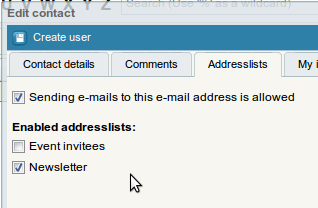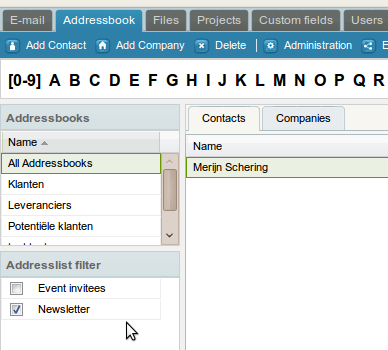| This manual is deprecated. Please visit https://groupoffice.readthedocs.io for the latest documentation. |
Difference between revisions of "Addresslists and newsletters"
| Line 5: | Line 5: | ||
#Quickly select the members in this list in a regular e-mail | #Quickly select the members in this list in a regular e-mail | ||
| + | ==Creating an addresslist== | ||
To create a list go to: | To create a list go to: | ||
Addressbook -> Administration -> Addresslists | Addressbook -> Administration -> Addresslists | ||
| − | + | Click on "Add" in that tab. Enter a name and click on "Apply" to save it. | |
| − | [[Image:Add-contacts-at-addresslist.png]] | + | Now you can add contacts in the addresslist dialog: |
| + | |||
| + | [[Image:Add-contacts-at-addresslist.png|Addresslist dialog]] | ||
Or you can check multiple lists at the "Edit contact" dialog: | Or you can check multiple lists at the "Edit contact" dialog: | ||
| Line 17: | Line 20: | ||
[[Image:Select-addresslist-at-contact.png]] | [[Image:Select-addresslist-at-contact.png]] | ||
| − | + | ==Filtering on addresslists== | |
Once you created some addresslists a filter appears at the left in the addressbook. This is useful to quickly view the contents of a list: | Once you created some addresslists a filter appears at the left in the addressbook. This is useful to quickly view the contents of a list: | ||
| Line 23: | Line 26: | ||
| − | + | ==Sending newsletters / mailings== | |
[[Image:Email_template.png|right|thumb|An example e-mail template]] | [[Image:Email_template.png|right|thumb|An example e-mail template]] | ||
To send a newsletter go to: | To send a newsletter go to: | ||
| Line 41: | Line 44: | ||
<b>Note:</b>You can also simply select the list from the addressbook at the e-mail composer. This is useful for small lists only. | <b>Note:</b>You can also simply select the list from the addressbook at the e-mail composer. This is useful for small lists only. | ||
| − | + | ===Using a special SMTP server=== | |
If you want to use a different SMTP server to send all mailings you can set the following config variables: | If you want to use a different SMTP server to send all mailings you can set the following config variables: | ||
Revision as of 17:24, 13 January 2010
Addresslists are useful for:
- Sending newsletters
- Categorize contacts because you can filter on them too
- Quickly select the members in this list in a regular e-mail
Contents
Creating an addresslist
To create a list go to:
Addressbook -> Administration -> Addresslists
Click on "Add" in that tab. Enter a name and click on "Apply" to save it.
Now you can add contacts in the addresslist dialog:
Or you can check multiple lists at the "Edit contact" dialog:
Filtering on addresslists
Once you created some addresslists a filter appears at the left in the addressbook. This is useful to quickly view the contents of a list:
Sending newsletters / mailings
To send a newsletter go to:
Addressbook -> Send mailing
Select a template if you have created one and select the list to send the newsletter too. Now simply compose your e-mail like you would do with a normal e-mail and click at send.
Datafields in the template will be replaced with data from the addressbook so you can created personalized e-mails.
A background process will send the e-mails. It will send it slowly so it won't bring the server down. You can check the progress at:
Addressbook -> Administration -> Addresslist -> Doubleclick the list and click at Sent mailings
Note:You can also simply select the list from the addressbook at the e-mail composer. This is useful for small lists only.
Using a special SMTP server
If you want to use a different SMTP server to send all mailings you can set the following config variables:
$config['mailing_smtp_encryption']="ssl";//empty, ssl or tls $config['mailing_smtp_server']="smtp.bulkmail.com"; $config['mailing_smtp_port']="25"; $config['mailing_smtp_username']=""; $config['mailing_smtp_password']="";




